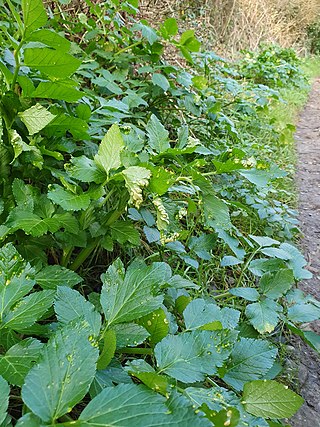
Rusts are fungal plant pathogens of the order Pucciniales causing plant fungal diseases.

Puccinia hordei is a species of rust fungus. A plant pathogen, it can cause leaf rust of barley, also known as brown rust of barley. It was originally found on the dry leaves of Hordeum vulgare in Germany.
Puccinia cacabata is a fungal species and plant pathogen that causes rust on cotton. It was originally found on the leaves of Chloris ciliata in Bolivia.
Pseudocercospora purpurea is a fungal plant pathogen that causes a leaf spot on the avocado. Species Cercospora purpurea was originally found on the leaves of Persea species in Georgia, USA in 1878. before the species was transferred to the Pseudocercospora genus in 1976.
Puccinia kuehnii is a plant pathogen that causes orange rust disease of sugarcane. Orange rust was first discovered in India in 1914, but the first case of huge economical damage in sugarcane was registered in Australia in 2001. The first case in United States was in 2007 in Florida and has so far been the only state in the United States where sugarcane has been affected by this kind of rust. In order to treat the infected sugarcane at least three rounds of fungicide must be applied to the plant, costing growers $40 million a year. Currently scientists at the Agricultural Research Service are genetically analyzing the fungus that causes orange rust in order to help combat the problem.

Puccinia melanocephala is a fungus and plant pathogen, it is the causal agent of sugarcane rust. It was originally found on the leaves of a species of Arundinaria (cane) in Assam, India.

Puccinia menthae is a fungal plant pathogen that causes rust on mint plants. It was originally found on the leaves of Mentha aquatica.

Puccinia pelargonii-zonalis is a fungal species and plant pathogen that causes rust on Pelargonium geraniums. It was originally found on the leaves of Pelargonium zonale in KwaZulu-Natal, South Africa.
Puccinia subnitens is a fungal species and plant pathogen that causes rust on Beta vulgaris. It was originally found on Distichlis spicata in Montana, USA.

Puccinia recondita is a fungus species and plant pathogen belonging to the order of Pucciniales and family Pucciniaceae.
Puccinia erianthi is a species of fungus and a plant pathogen. It was originally found on the leaves of Erianthus fulvus in Punjab, India. It is a common cause of sugarcane rust.

Uromyces is a genus of rust fungi in the family Pucciniaceae. The genus was described by Franz Unger in his 1833 work Die Exantheme der Pflanzen. They have a worldwide distribution but large occurrences happen in North America and Europe.

Puccinia horiana is a species of fungus that causes chrysanthemum white rust, is a disease of plant species of the genus Chrysanthemum.

Puccinia malvacearum, also known as hollyhock or mallow rust, is a fungal species within the genus Puccinia known for attacking members of the family Malvaceae. An autoecious pathogen, it can complete its life cycle using a single host.

Puccinia poarum, a species of fungus, known as the coltsfoot gall rust, or meadow grass rust, is a plant pathogen. This fungal parasite forms a yellow to orange gall, 1–2 cm in diameter, on the underside of leaves of coltsfoot. It also infects but does not gall grasses of the family Poaceae. P. poarum is a genetically diverse species that has been reported on at least seventy plant hosts. It was originally found on Poa fertilis and Poa nemoralis in Denmark in 1877.

Austropuccinia is a monotypic genus of rust native to South America with the only species Austropuccinia psidii, commonly known as myrtle rust, guava rust, or ʻōhiʻa rust. It affects plants in the family Myrtaceae. It is a member of the fungal complex called the guava rust group. The spores have a distinctive yellow to orange colour, occasionally encircled by a purple ring. They are found on lesions on new growth including shoots, leaves, buds and fruits. Leaves become twisted and may die. Infections in highly susceptible species may result in the death of the host plant.

Puccinia sessilis is a fungal species and plant pathogen, which is also known as arum rust or ramsons rust. It commonly infects Arum maculatum and Allium ursinum causing yellow to orange circular patches on leaves. On the underside of the leaves, it produces raised orange aecia commonly covered in spores. It is common in Eurasia in the spring.

Puccinia umbilici is a fungal plant pathogen which causes rust on navelwort. It was originally found on the leaves of Umbilicus pendulinus in France. It is found in Europe, Japan, Russia and the United States.

Puccinia smyrnii, or alexanders rust, is a fungus species and plant pathogen which causes rust on alexanders. It was originally found in Sicily. It is found in Europe and parts of north Africa.
Puccinia gansensis is a species of fungus and a plant pathogen. It was originally found on the leaves of on Achnatherum inebrians in Gansu, China.














